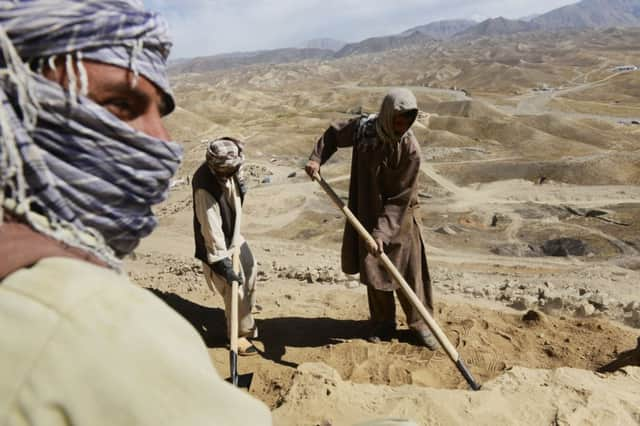Copper mines threat to Afghanistan’s Buddhist past


An estimated 5.5 million tons of copper, one of the biggest deposits in the world, could provide a major export for a war-ravaged country desperately in need of jobs and cash. But the hoped-for bonanza also could endanger rare artifacts that survived the rule of the Taleban and offer a window into Afghanistan’s rich pre-Islamic history.
“The copper mine and its extraction are very important. But more important is our national culture,” said Abdul Qadir Timor, director of archaeology at Afghanistan’s culture ministry. “Copper is a temporary source of income. Afghanistan might benefit for five or six years after mining begins, and then the resource comes to an end.”
Advertisement
Hide AdAdvertisement
Hide AdThe government is determined to develop Afghanistan’s estimated $3 trillion worth of minerals and petroleum, an untapped source of revenue that could transform the country. The withdrawal of US-led combat forces at the end of 2014 and a drop in foreign aid have left the government strapped for cash. It hopes to attract global firms to exploit oil, natural gas and minerals, ranging from gold and silver to the blue lapis lazuli for which the country has been known since ancient times.
Beijing’s state-run China Metallurgical Group struck a $3 billion deal in 2008 to develop a mining town at Mes Aynak with power generators, road and rail links, and smelting facilities. Workers built a residential compound, but were pulled out two years ago because of security concerns. Nazifullah Salarzai, a spokesman for President Ashraf Ghani, said the government is keen to finish that project.
Archaeologists are scrambling to uncover a trove of artifacts at the site dating back nearly 2,000 years which shed light on a Buddhist civilization that stretched across India and China, reaching all the way to Japan.
“The more we look, the more we find,” archaeologist Aziz Wafa said as he scanned hilltops pock-marked with bowl-shaped hollows where copper powder was once melted down and painted on to ceramics. Excavators have found silver platters, gold jewelry and a human skeleton as they have uncovered the contours of a long-lost town that once hosted elaborate homes, monasteries, workshops and smelters.
Behind Wafa is a cave in which three Buddhas are seated around a dome-shaped shrine known as a stupa. Two are headless; one was decapitated by looters who entered through a tunnel. The other head was removed by archaeologists and placed in storage along with thousands of other items. Movable objects, including sculptures, coins and ceramics, are stored at the National Museum in Kabul. Larger objects, including stupas measuring 26 feet across and statues of robed monks 23 feet tall remain at the sprawling site, which is closed off and protected by a special security force.
The roads are lined with armed guards and the archaeologists have no telephone or internet access.
Experts believe that proselytizing Buddhist monks from India settled here in the 2nd century AD. Like today’s miners, they were enticed by the copper, which they fashioned into jewelry and other products to trade on the Silk Road linking China to Europe.
Until the giant Buddhas of Bamiyan were dynamited by the Taleban in 2001, few knew that Afghanistan was once a wealthy, powerful Buddhist empire. A fact that does not feature on the local education curriculum.